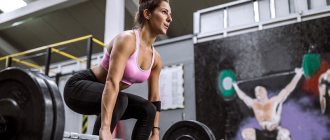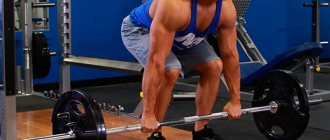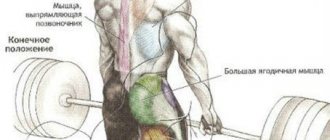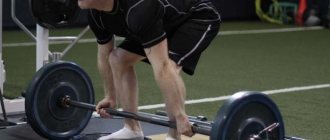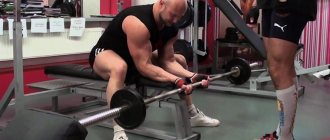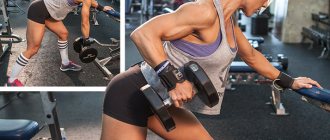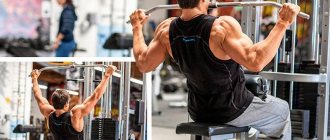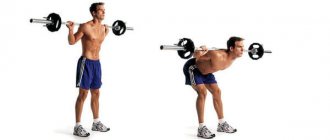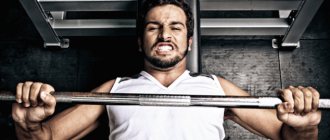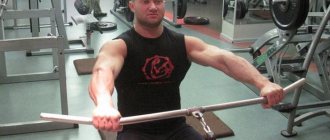Deadlift is one of the main basic multi-joint exercises in triathlon, weightlifting and powerlifting, where 3/4 or 70% of the total muscle mass of the body is stressed.
Effectively builds muscle, increases endurance and strength, can be used both during a mass-gaining cycle and during cutting. For men, the exercise is useful because, due to the high load, it significantly increases the secretion of testosterone.
The classic deadlift has many advantages, first of all, it helps in the development of strong and powerful muscles. The exercise itself is considered very energy-intensive. Main difficulties:
- Some people consider the deadlift to be a very traumatic exercise. As a conclusion, it is not worth doing. But, in fact, injuries can only be caused by not following the technique.
- Barbell deadlifts help strengthen your lower back by strengthening your back extensors. Alas, many beginners, as well as seasoned and experienced athletes, neglect this exercise, considering it difficult and dangerous. They simply do not realize the full effectiveness of this basic exercise.
Deadlift has no analogues in iron sports.
The basic idea behind a deadlift is that you bend over and lift a certain amount of weight. The movement is quite simple, but in order for the muscles to get a load, you must perform the exercise correctly.
The classic technique involves performing on bent legs, with an arched back. By strictly and clearly following the technique of performing the exercise, the risk of injury is reduced to zero.
Some athletes believe that deadlifts increase their waist size. Indeed, due to the active participation of the abdominal muscles, they become stronger.
This is why many bodybuilders, in particular those who compete at Mens Physique (Mens Physique), do not do this exercise. After all, they need a very narrow waist. Moreover, with a thin waist it is difficult to do deadlifts. Since the abdominal muscles will poorly stabilize the body.
But, in general, regular exercise does not significantly increase your waistline. The increase itself occurs solely due to the pumping of the abdominal muscles.
What muscles work?
The exercise involves many large and small groups, which develops the whole body. However, inquiring minds often wonder what exactly the deadlift does? Let's try to figure it out in detail.
The following muscle groups are primarily involved:
- Back. Most of the load falls on the back extensor muscles. It is strengthened from the neck to the sacrum. The back swings more in depth than in width.
- Legs. The load falls on the quadriceps; the hamstrings and buttocks take an active part, but with the least load.
Speaking of the classic version, it places a small load on the buttocks and hamstrings. Therefore, for girls who want to pump up these two muscle groups well, they need to perform Romanian deadlifts on straight legs.
The secondary muscles are:
- Hands. Most of the load falls on parts of the arm such as the hands and forearm. Biceps and triceps experience static load. Keeping a barbell suspended, especially with heavy weights, is not an easy task.
- Trapezoid. Due to the convergence of the shoulder blades, it is in constant tension.
- Abdominal muscles. The rectus and oblique muscles act as stabilizers, preventing the body from swaying, keeping it in a safe position.
- Calves and hamstrings. They hold the legs in the desired position, preventing them from moving apart.
Recommendations for technique
- Under no circumstances should you start performing deadlifts without preparation. You should master the classic version of the deadlift well enough, otherwise the risk of injury increases. You need to be able to fix your back very well.
- If you are a beginner, you can try to take the projectile not from the floor, but from a stand, bench or other elevated area.
- Don't grip the bar too wide. If in the classic version this is acceptable, then when performing deadlifts it is not.
- To better hold the weight, the projectile can be taken with a different grip (a grip in which one palm is facing you, the other is facing away from you). This will protect your hands from excessive stress.
- It also makes sense to try doing the exercise with a trap bar; this option will probably be the most convenient for some.
- Even though the exercise is called a straight-legged deadlift, your knees should be slightly bent at the bottom point. This will help keep your lower back straight.
- You can adjust the position of your back based on your shoulder blades. If you feel that your shoulder blades are tense and moving towards each other, you are doing everything right, your back is straight. If your shoulder blades move apart, it means you have begun to slouch.
- During the exercise, you must ensure that your weight rests on your heels, and do not lift them off the floor under any circumstances.
- When straightening at the top point, it is important to tense your buttocks and move your pelvis slightly forward.
- If the classic deadlift is performed most often on the day when the back is trained, then the deadlift should be left for the day of the leg training. Once a week will be enough.
- Before deadlifting, you should perform hyperextension. Do 3 sets of 15 repetitions - this will warm up all the necessary muscles.
A good option for performing deadlifts is a trap bar.
Deadlifts are great for both women and men. This exercise strengthens your hips and back, and when done correctly, you will notice how your body transforms before your eyes and your strength levels increase significantly.
Deadlift - correct technique
The exercise, without exaggeration, can be called quite difficult. In technique, every detail plays an important role, so we will try to describe as succinctly as possible how to do a deadlift correctly.
It is important to attach maximum importance to each point. Thus, get the maximum effect from the exercise and reduce the risk of injury to a minimum.
As we said above, the biomechanics of the deadlift are quite simple; the main goal of the athlete is to lift the required weight from the floor, loading the target muscles. But this must be done as correctly as possible:
- The classic version is performed on bent legs.
- For the exercise you will need a regular lifting bar, pancakes and the desire to do everything right.
- We place the bar empty or with weight on a power rack or floor in front of us.
- You definitely need to warm up! It’s even better if 1-2 approaches are with a light weight or an empty bar.
Which grip should you choose? For many, it becomes a “stumbling block”, because it will determine how comfortable it is to hold the bar. Kinds:
- Classic. The best solution is to use a classic grip - knuckles facing out.
- Different grips. Some athletes, when working with heavy weights, recommend an overhand grip, as it allows you to hold large weights. Yes, this is true, but there is a significant disadvantage - violation of symmetry and increased load on the spine. However, there is a more rational solution - using straps. They allow you to eliminate the forearm from work.
- Back. In this case, a large load is placed on the biceps and it is very difficult to perform the exercise with such a grip, especially if there is a lot of weight on the barbell. Also, if your forearms cannot support the weight, it is recommended to strengthen your grip.
Correct deadlift technique:
- Starting position. The most successful position of the legs is slightly narrower than shoulder width. The feet must be parallel to each other. The back is straight, chest forward. Mandatory arching in the lower back. To do this, you need to move your pelvis back. The neck is straight, the gaze is directed forward. Under no circumstances should you lift your head or round your back.
- Let's take the neck. To grab the bar, we tilt the body forward, maintaining the position of the body. As you lean forward, your knees will begin to bend, which is normal. The tilt angle is approximately 50 degrees. At the lowest point, we lower our hands; they should be flush with the surface of the shin. To grab the bar, you need to sit down a little, while the body is fixed straight.
Using the method described above, you can lift not only the barbell, but also any heavy objects both in the gym and in life:
- Let's check the position. Taking the barbell in your hands, make sure once again that your legs are in the desired position, your lower back is arched, your back is straight, and your shoulder blades are brought together.
- Upward movement. Maintaining the position of the body, we rise to the top with the bar in our hands. It is very important that the body weight is not transferred to the toes, and the body does not sway. During this phase of the movement, the athlete should feel how the back of the thigh and buttocks work. With their help, it is possible to push the pelvis forward. In this case, you cannot use your back and lower back to help, otherwise you can get injured.
- Downward movement. We lower the barbell down, while at the same time moving the hip back. The bar should seem to slide down, parallel to the shin. After the thigh is pulled back as far as possible, the bar should be at the level of the knees, after which we begin to bend the knees. The gaze is directed forward, the spine is in a neutral position, without bending in the lower back.
How to do a barbell deadlift correctly
To get your back in order, increase muscle mass in your back muscles and the whole body, and also become stronger, you need to perform barbell rows using the correct technique. I began to consistently include deadlifts in my training program and it brought significant benefits. After a series of my first performances at professional shows in 2010, the judges could not believe the changes that had occurred in the size of the back muscles and their density. Now, 5 years later, my back has gotten even bigger, as has my success in deadlifting.
Warm up before deadlifts and squats
Before performing a deadlift, you must do a specific warm-up, that is, aimed at warming up those muscle groups that are directly involved in the exercise. This includes light mobility work and exercises to activate the muscles involved in lifting.
When I started deadlifting, I wasn't just lifting heavy weights. I have tried different types of this exercise and different ways of doing them. I was taught this by some of the best people I know, including Ben Esgro, Dr. Mike Zordes, and USAPL World Team Head Coach Matt Gary. The knowledge I gained led me to excellent results. I will share this knowledge with you and teach you how to deadlift safely and effectively in both the classic and sumo style.
Don't be afraid of deadlifts. Learn this exercise with my guidance!
Breathing as an important part of the exercise
Proper breathing is an important element of deadlifting. Therefore, let’s try to figure out what proper breathing should be like when deadlifting.
The main task is to maintain the spine in a stable position. Breathing control is very important, so it is recommended to pay enough attention to it.
The main task of breathing is to ensure stability of the spine in the lower part and prevent it from rounding. Since the exercise is quite difficult to perform, it is very important to control the breathing cycle.
Do you want to improve your figure and health, without harming your spine and joints? Get my free resources on smart fitness at the gym or at home and learn how to exercise the right way!
They are suitable for both beginners and advanced fitness fans.
